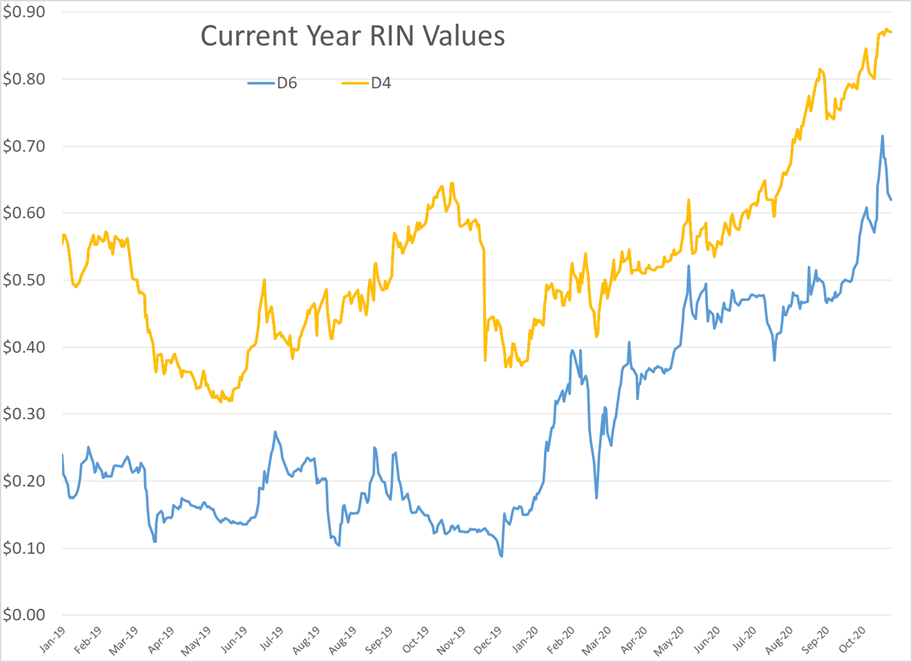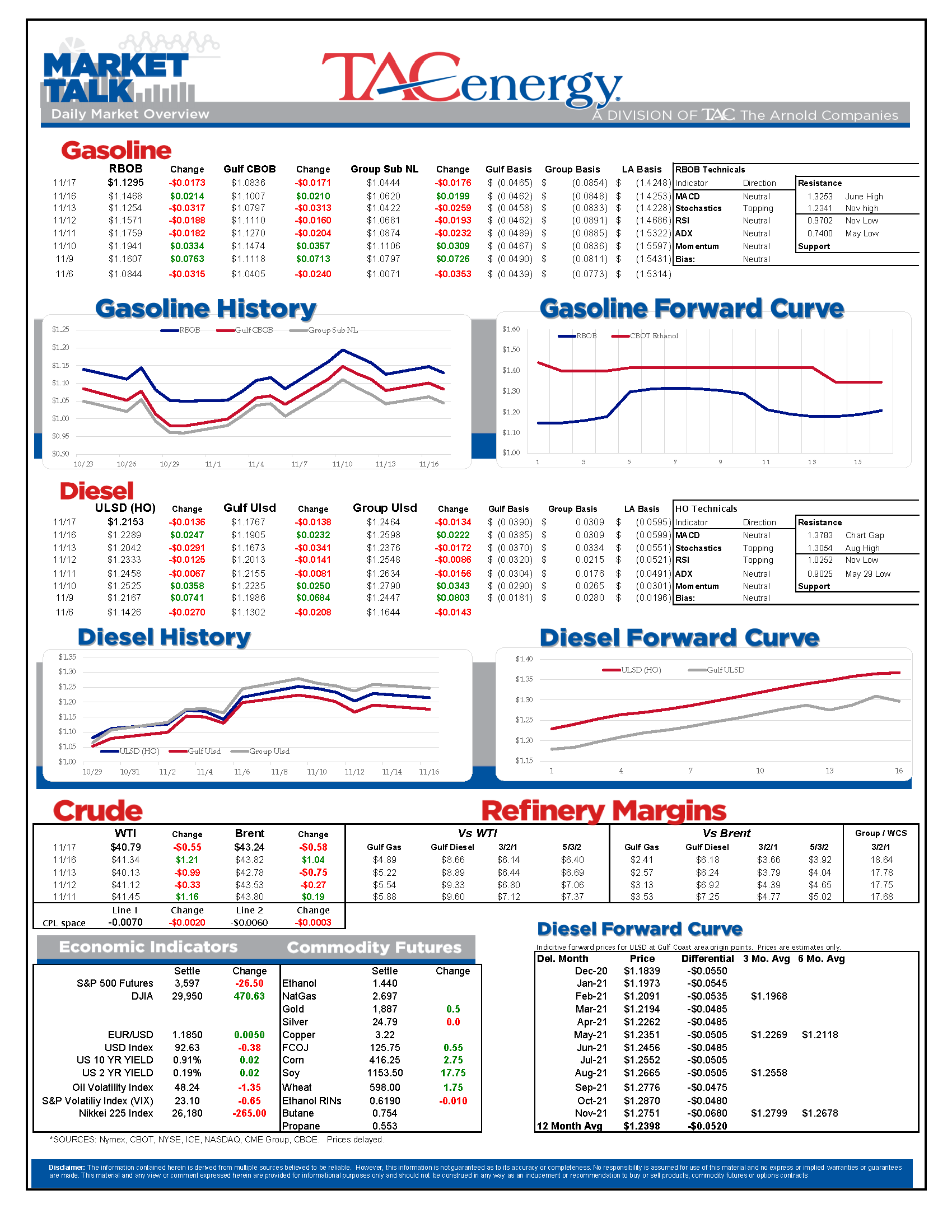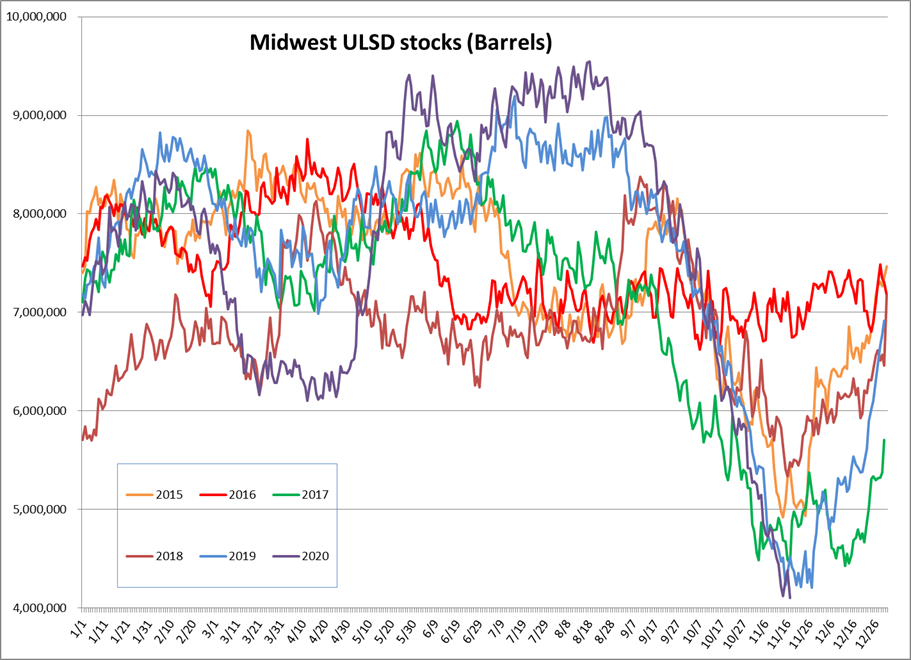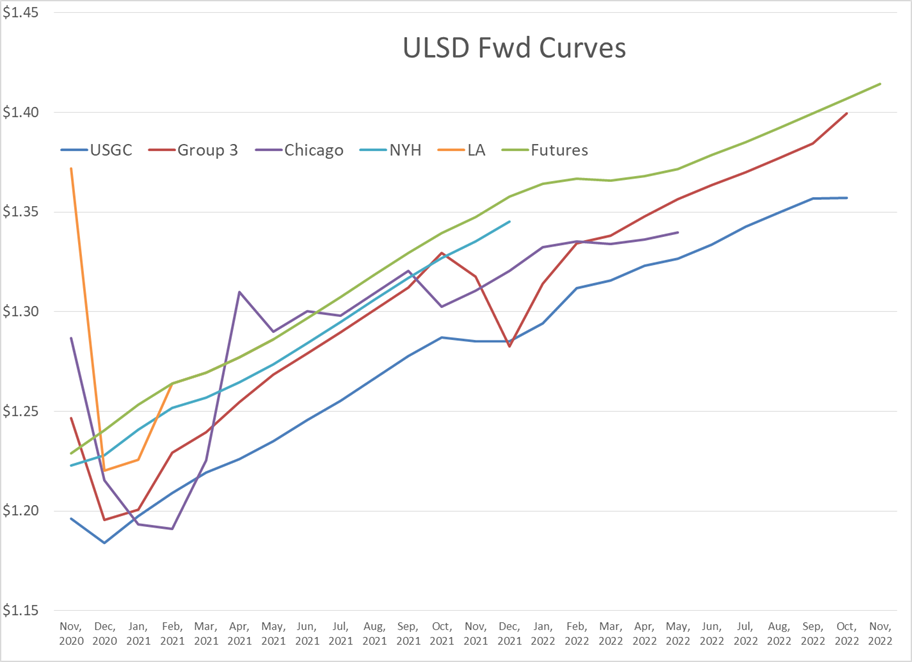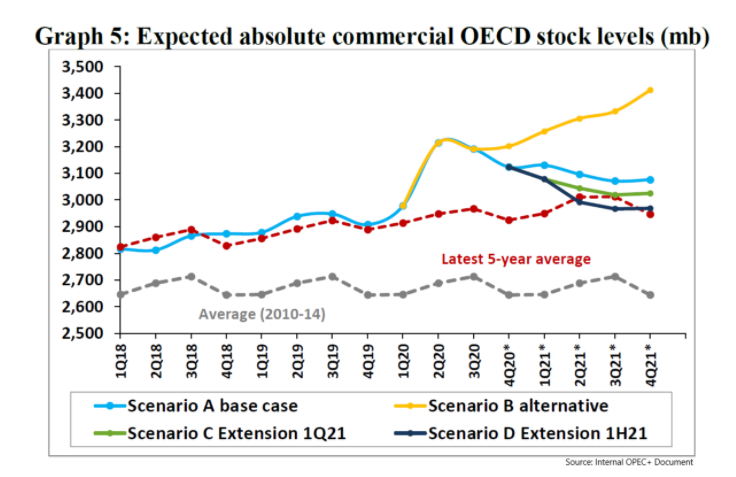Shutdown Pessimism Outweighs Vaccine Optimism

Energy and equity markets are giving back most of Monday’s gains in the early going Tuesday as shutdown pessimism seems to be outweighing vaccine optimism today.
New state-wide restrictions are popping up from coast to coast just ahead of one of the busiest travel weeks of the year, which will certainly put some more downward pressure on fuel demand, although the extent remains to be seen.
After being the weak link in the energy chain for months, distillates have had a strong performance this fall as inventories in several regions dropped to normal levels thanks to a slow recovery in demand and plummeting output from refiners. We can see evidence of that dramatic change in the chart of Midwestern diesel stocks below that shows inventories going from all-time highs in August, to an eight-year-low today. The annual harvest demand peak, and a pull from neighboring states to the West seem to be the major contributors to that rapid drawdown, with W. Texas, New Mexico, Arizona, Colorado and Nevada all finding themselves suddenly short on diesel supply. Cash markets suggest this will be a short-lived phenomenon with steep backwardation into December foreshadowing a recovery in supplies, and the seasonal demand drop, both coming soon.
Reuters is reporting that documents leaked from OPEC’s technical committee make the case for another three to six month extension of the current output cuts. We should find out two weeks from today if that plan is adopted by the cartel.
See this note for a listing of all the refinery closures/conversions announced around the world so far, which total roughly 1.7 million barrels/day of capacity. The exception to the current refining rule of weak margins appears to be China, as the country’s plants reached another output record in October amidst healthy domestic demand.
U.S. refiners are not so lucky, and are facing yet another new challenge as the ordered shut down of Enbridge’s line 5 puts more plants in MI and OH at an even greater risk of being unable to operate economically, although it could be a life saver for other refiners in the mid-continent who have the logistics in place to make a home for that newly distressed crude oil coming from western Canada.
The line 5 saga is just one of several pieces of political theater impacting energy markets since the election. RIN values had been on a tear since the renewable friendly Presidential victory was called, but D6 values have pulled back sharply this week after the EPA administrator said RIN values were “out of control” and that the agency would not release RVO targets for 2021 by the Nov. 30 deadline.
In addition, nominations for drilling in ANWR have been opened up, leaving just enough time for potential leases to be signed before the presidential inauguration. The flurry of events in the past few days suggests we are likely to see more moves from the democratically warring factions in the weeks ahead.
Click here to download a PDF of today's TACenergy Market Talk.
Latest Posts
Gasoline Futures Are Leading The Way Lower This Morning
The Sell-Off Continues In Energy Markets, RBOB Gasoline Futures Are Now Down Nearly 13 Cents In The Past Two Days
Week 15 - US DOE Inventory Recap
Prices To Lease Space On Colonial’s Main Gasoline Line Continue To Rally This Week
Social Media
News & Views
View All
Gasoline Futures Are Leading The Way Lower This Morning
It was a volatile night for markets around the world as Israel reportedly launched a direct strike against Iran. Many global markets, from equities to currencies to commodities saw big swings as traders initially braced for the worst, then reversed course rapidly once Iran indicated that it was not planning to retaliate. Refined products spiked following the initial reports, with ULSD futures up 11 cents and RBOB up 7 at their highest, only to reverse to losses this morning. Equities saw similar moves in reverse overnight as a flight to safety trade soon gave way to a sigh of relief recovery.
Gasoline futures are leading the way lower this morning, adding to the argument that we may have seen the spring peak in prices a week ago, unless some actual disruption pops up in the coming weeks. The longer term up-trend is still intact and sets a near-term target to the downside roughly 9 cents below current values. ULSD meanwhile is just a nickel away from setting new lows for the year, which would open up a technical trap door for prices to slide another 30 cents as we move towards summer.
A Reuters report this morning suggests that the EPA is ready to announce another temporary waiver of smog-prevention rules that will allow E15 sales this summer as political winds continue to prove stronger than any legitimate environmental agenda. RIN prices had stabilized around 45 cents/RIN for D4 and D6 credits this week and are already trading a penny lower following this report.
Delek’s Big Spring refinery reported maintenance on an FCC unit that would require 3 days of work. That facility, along with several others across TX, have had numerous issues ever since the deep freeze events in 2021 and 2024 did widespread damage. Meanwhile, overnight storms across the Midwest caused at least one terminal to be knocked offline in the St. Louis area, but so far no refinery upsets have been reported.
Meanwhile, in Russia: Refiners are apparently installing anti-drone nets to protect their facilities since apparently their sling shots stopped working.
Click here to download a PDF of today's TACenergy Market Talk.

The Sell-Off Continues In Energy Markets, RBOB Gasoline Futures Are Now Down Nearly 13 Cents In The Past Two Days
The sell-off continues in energy markets. RBOB gasoline futures are now down nearly 13 cents in the past two days, and have fallen 16 cents from a week ago, leading to questions about whether or not we’ve seen the seasonal peak in gasoline prices. ULSD futures are also coming under heavy selling pressure, dropping 15 cents so far this week and are trading at their lowest level since January 3rd.
The drop on the weekly chart certainly takes away the upside momentum for gasoline that still favored a run at the $3 mark just a few days ago, but the longer term up-trend that helped propel a 90-cent increase since mid-December is still intact as long as prices stay above the $2.60 mark for the next week. If diesel prices break below $2.50 there’s a strong possibility that we see another 30 cent price drop in the next couple of weeks.
An unwind of long positions after Iran’s attack on Israel was swatted out of the sky without further escalation (so far anyway) and reports that Russia is resuming refinery runs, both seeming to be contributing factors to the sharp pullback in prices.
Along with the uncertainty about where the next attacks may or may not occur, and if they will have any meaningful impact on supply, come no shortage of rumors about potential SPR releases or how OPEC might respond to the crisis. The only thing that’s certain at this point, is that there’s much more spare capacity for both oil production and refining now than there was 2 years ago, which seems to be helping keep a lid on prices despite so much tension.
In addition, for those that remember the chaos in oil markets 50 years ago sparked by similar events in and around Israel, read this note from the NY Times on why things are different this time around.
The DOE’s weekly status report was largely ignored in the midst of the big sell-off Wednesday, with few noteworthy items in the report.
Diesel demand did see a strong recovery from last week’s throwaway figure that proves the vulnerability of the weekly estimates, particularly the week after a holiday, but that did nothing to slow the sell-off in ULSD futures.
Perhaps the biggest next of the week was that the agency made its seasonal changes to nameplate refining capacity as facilities emerged from their spring maintenance.
PADD 2 saw an increase of 36mb/day, and PADD 3 increased by 72mb/day, both of which set new records for regional capacity. PADD 5 meanwhile continued its slow-motion decline, losing another 30mb/day of capacity as California’s war of attrition against the industry continues. It’s worth noting that given the glacial pace of EIA reporting on the topic, we’re unlikely to see the impact of Rodeo’s conversion in the official numbers until next year.
Speaking of which, if you believe the PADD 5 diesel chart below that suggests the region is running out of the fuel, when in fact there’s an excess in most local markets, you haven’t been paying attention. Gasoline inventories on the West Coast however do appear consistent with reality as less refining output and a lack of resupply options both continue to create headaches for suppliers.

